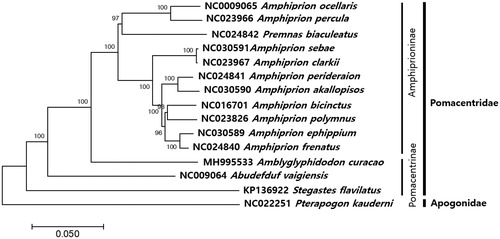Abstract
The complete mitochondrial genome of the Staghorn damselfish, Amblyglyphidodon curacao was determined by next-generation sequencing (NGS) platform. The circular mitochondrial genome of A. curacao (16,612 bp) encoded the 13 protein-coding genes, 22 tRNA genes, 2 rRNA genes, and 2 non-coding regions (origin of light strand replication (OL) and the control region (D-Loop)). All the tRNAs have typical clover-leaf structures except for tRNA-Ser. Phylogenetic analysis based on the currently reported mitochondrial genomes in Pomacentridae showed that A. curacao was most closely related to Amphiprion frenatus. The complete mitogenome sequence of A. curacao would provide essential genetic information of Pomacentrinae related to them for their scientific management in the coral-reef ecosystem in Indonesian waters.
Although the pomacentrids represent the greatest diversity and abundance of fish species inhabiting around coral reef zone (Meekan et al. Citation1995), the documentation of their genetic information is still lacking, especially in subfamily Pomacentrinae. Based on FishBase (fishbase.org), there are currently 11 recognized species in this genus Amblyglyphidodon but no mitochondrial genome information is currently documented. Amblyglyphidodon curacao also known as a staghorn damsel inhabits the tropical and subtropical coral reefs as one of the ecologically important components (Allen Citation1991). We here report the complete mitochondrial genome of A.curacao firstly in genus Amblyglyphidodon.
The specimen was collected from the coastal water at Thousand islands, Jakarta, Indonesia (5°44'41.03"S, 106°35'36.97"E), which stored at Sekolah Tinggi Perikanan, Jakarta, Indonesia. Species identification of the specimen was confirmed by both its morphological characteristics and DNA sequence identity in the COI region to the GenBank database (KF929588). Mitochondrial DNA was extracted by a commercial kit (Abcam, Cambridge, UK), followed by the fragmentation of the purified mitochondrial DNA into smaller sizes (∼350 bp) by Covaris M220 Focused-ultrasonicator (Covaris Inc., Woburn, MA, USA). A library for sequencing was constructed by TruSeq® RNA library preparation kit V2 (Illumina Inc., San Diego, CA, USA) and its quality and quantity were analyzed by 2100 Bioanalyzer (Agilent Technologies, Santa Clara, CA, USA). DNA sequencing was performed by MiSeq sequencer (Illumina, San Diego, CA, USA) and the complete mitogenome of A. curacao was assembled by Geneious v 11.0.2 (Kearse et al. Citation2012).
The complete mitochondrial genome of A. curacao (MH995533) was 16,612 bp in length, which consisted of 13 protein-coding genes, 22 tRNAs, 2 ribosomal RNAs (12S and 16S), and non-coding regions including putative control region D-Loop (842 bp) and origin of light strand replication OL (30 bp). The three tRNA clusters (IQM, WANCY, and HSL) were also well conserved (Satoh et al. Citation2016). Secondary structure prediction result by ARWEN (Laslett and Canbäck Citation2008) showed that all the tRNAs have typical clover-leaf structures except for tRNA-Ser. The non-coding region D-Loop was identified between tRNA-Pro(TGG) and tRNA-Phe(GAA) while the OL was between tRNA-Asn(GTC) and tRNA-Cys(GCA) at WANCY cluster. The protein-coding region was initiated with ATG except for COX1 gene which initiated by GTG. Incomplete stop codons were identified in ND2, COX2, ATP6, COX3, ND3, ND4, ND5, and Cyt b genes.
The phylogenetic analysis of A. curacao with the currently reported mitogenome in family Pomacentridae was constructed by MEGA7 with minimum evolution algorithm (Kumar et al. Citation2016). Amblyglyphidodon curacao was clustered with those in subfamily Pomacentrinae including Stegastes flavilatus and Abudefduf vaigiensis, which is distinct from those in subfamily Amphiprioninae (). However, A. curacao showed the highest sequence identity to Amphiprion frenatus (87%) among the currently identified mitogenomes in family Pomacentridae and more mitogenome information of subfamily Pomacentrinae should be supplemented to provide the basic information about the genetic structure within the family Pomacentridae.
Figure 1. Phylogenetic tree of Amblyglyphidodon curacao within Pomacentridae. Phylogenetic tree of Amblyglyphidodon curacao complete genome was constructed by MEGA7 software with Minimum Evolution (ME) algorithm with 1000 bootstrap replications. Each scientific name followed by GenBank Accession numbers and furthermore Pterapogon kauderni (NC022511) family of Apogonidae as an outgroup.

Disclosure statement
The authors report that they have no conflicts of interest. The authors alone are responsible for the content and writing of the manuscript.
Additional information
Funding
References
- Allen GR. 1991. Damselfishes of the world. Mele, Germany: MERGUS Publisher Hans A Baensch; p. 271.
- Kearse M, Moir R, Wilson A, Stones-Havas S, Cheung M, Sturrock S, Buxton S, Cooper A, Markowitz S, Duran C, et al. 2012. Geneious Basic: an integrated and extendable desktop software platform for the organization and analysis of sequence data. Bioinformatics. 28:1647–1649.
- Kumar S, Stecher G, Tamura K. 2016. MEGA7: molecular evolutionary genetics analysis version 7.0 for bigger datasets. Mol Biol Evol. 33:1870–1874.
- Laslett D, Canbäck B. 2008. ARWEN: a program to detect tRNA genes in metazoan mitochondrial nucleotide sequences. Bioinformatics. 24:172–175.
- Meekan M, Steven A, Fortin M. 1995. Spatial patterns in the distribution of damselfishes on a fringing coral reef. Coral Reefs. 14:151–161.
- Satoh TP, Miya M, Mabuchi K, Nishida M. 2016. Structure and variation of the mitochondrial genome of fishes. BMC Genomics. 17:719–738.
